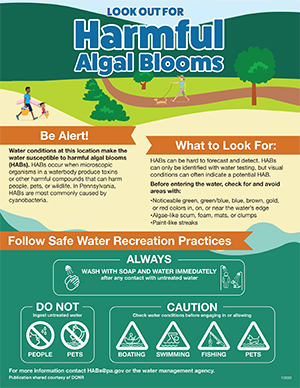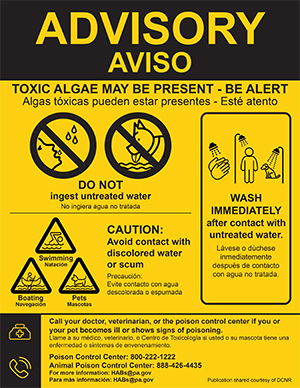Like many other parts of the nation and the world, an increased understanding and awareness of HABs has developed in Pennsylvania over recent years. To coordinate monitoring, response, and communications about HABs in Pennsylvania, several Commonwealth agencies and commissions formed the
Pennsylvania HABs Task Force, which includes representatives from:
- the Pennsylvania Department of Environmental Protection;
- the Pennsylvania Department of Health;
- the Pennsylvania Department of Conservation and Natural Resources;
- the Pennsylvania Department of Agriculture;
- the Pennsylvania Fish and Boat Commission;
- the Pennsylvania Game Commission; and
- the Pennsylvania Emergency Management Agency.
This webpage serves as the “HABs hub” for the Commonwealth’s interagency HABs task force. To learn more about HABs in Pennsylvania and the work of the Pennsylvania HABs Task Force,
check out this training module developed by the Pennsylvania Department of Health in collaboration with other members of the task force. To explore recent and historical HAB monitoring data across the Commonwealth, visit the task force’s interactive, map-based Pennsylvania HABs Dashboard.
More Information
HABs can impact health, the economy, and the environment, and these impacts can be severe depending on the timing, location, and intensity of a HAB.
-
Health impacts: Human health impacts associated with HABs include contamination of drinking water supplies and certain foods (e.g., shellfish) with cyanotoxins, and exposure to aerosolized cyanotoxins or other chemical compounds during recreational activities in or around a waterbody or waterway experiencing a HAB. HABs can also impact the health of pets, wildlife, and other animals. For more information on the health effects of HABs, see the Department of Health’s HABs webpage and the CDC’s HAB-Associated Illness webpage.
- Economic impacts: Economic impacts associated with HABs include decreased real estate values, decreases in recreation and tourism revenue, losses in agricultural productivity, and increased drinking water treatment costs.
- Environmental impacts: Environmental risks associated with HABs include decreased aquatic habitat quality.
HABs can occur in freshwater, marine, and brackish water bodies. The factors that contribute to HABs vary from waterbody to waterbody, but HABs most commonly occur in waters with: (1) calm, slow-moving, stagnant water; (2) high concentrations of key nutrients, like nitrogen and phosphorus; and (3) warm temperatures.
-
Calm, slow-moving waters: HABs most commonly occur in relatively slow-moving bodies of water such as lakes, ponds, reservoirs, bays, and estuaries. HABs also can occur in the pools of dammed river systems, such as the Ohio River. HABs less commonly occur in faster-moving waters, like high-gradient headwater streams, but cyanobacteria and cyanotoxins can be transported through faster-moving waterways from HABs occurring in upstream bodies of water.
- High-nutrient waters: Waters with high concentrations of key nutrients, such as nitrogen and phosphorus, are more likely to experience HABs. The most common sources of excess nitrogen in phosphorus in waterways and waterbodies include: stormwater runoff from agricultural, urban, and suburban landscapes; discharges from point source discharges like wastewater treatment plants and concentrated animal feeding operations; malfunctioning septic systems; cracked sewer pipes; and atmospheric deposition.
- Warmer waters: HABs typically occur during warmer months (i.e., mid-June to early September).
Prevention and Management of HABs
Although we still have a lot to learn about the complex and dynamic factors that contribute to HAB formation in specific waters at specific times, there are many existing resources and programs that address the general factors known to facilitate HAB formation, including:
- Pennsylvania Department of Environmental Protection
- Pennsylvania Department of Conservation and Natural Resources
- State Conservation Commission
Definitively identifying a HAB requires laboratory analysis of a sample from a waterbody, but visual observations of conditions in a waterbody is one of the most readily available strategies to identify a suspected HAB. The presence of a HAB cannot be confirmed by visual observation alone, and it takes some training and experience to learn to recognize suspected HABs by sight, but visual observation can be an important tool in the HAB monitoring toolbox.
If a HAB is suspected or confirmed to be occurring in a body of water, it is strongly recommended for people and pets to avoid contact with the water and avoid ingesting the water. If you or your pet becomes ill or shows signs of poisoning after being in or around a waterbody with a suspected or confirmed HAB, call your doctor, veterinarian, or the poison control center: Poison Control Center 800-222-1222; Animal Poison Control Center 888-426-4435.
If you have any health-related questions about HABs, please contact the Division of Environmental Health Epidemiology at the Pennsylvania Department of Health at
env.health.concern@pa.gov. To report a suspected HAB, or for other inquiries about HABs, contact the Pennsylvania HABs Task Force at HABs@pa.gov.
Depending on the specific organisms in a HAB and the specific weather and water conditions in which a HAB occurs, HABs can take on different visually observable characteristics. Any or all following visually observable conditions may indicate a suspected HAB:
- water that is usually clear becomes bright green, opaque, or otherwise discolored, in a uniform fashion and/or in globs (i.e., colonies), on and/or below the surface;
- water may appear soupy;
- water surface may appear to have grass clippings or paint like streaks; or
- surface scum or algal mats on the water surface or shoreline.
Here are some photographs of suspected and confirmed HABs in Pennsylvania waterbodies and waterways.
.png)
For more information and resources on how to visually identify potential HABs, see:
If a HAB is suspected or confirmed to be occurring in a body of water, it is strongly recommended for people and pets to follow safe water recreation practices to limit exposure:
- Wash your hands after contact with untreated water
- Shower or bathe people and pets immediately after participating in water-based recreation activities
- Avoid swallowing and inhaling untreated water during recreational activities
- Avoid contact with water that has foam, scum, or discoloration
- Seek and follow any waterbody advisories or closures
If you or your pet becomes ill or shows signs of poisoning after being in or around a waterbody with a suspected or confirmed HAB, call your doctor, veterinarian, or the poison control center: Poison Control Center 800-222-1222; Animal Poison Control Center 888-426-4435.
If you have any health-related questions about HABs, please contact the Division of Environmental Health Epidemiology at the Pennsylvania Department of Health at
env.health.concern@pa.gov.
To report a suspected HAB, or for other inquiries about HABs, contact the Pennsylvania HABs Task Force at
HABs@pa.gov.
Be on the lookout for HABs
watch,
advisory, and
warning signage.



What are the bacteria and/or toxin levels of concern for HAB events?
The Pennsylvania HABs Task Force, comprised of representatives from the Departments of Health, Environmental Protection, Agriculture, Conservation and Natural Resources, Pennsylvania Emergency Management Agency, Game Commission, and Fish and Boat Commission, has developed a
Watch recommendation for the purposes of communicating to the public that conditions could lead to a HAB and that users should be attentive.
A Watch recommendation is appropriate when:
- Visual observations indicate conditions are optimal for a HAB;
- Waterbodies without public swimming beaches experience colony counts or toxin concentrations that exceed response level thresholds;
- Waterbodies with public swimming beaches experience colony counts or toxin concentration that exceed response level thresholds outside swimming areas;
- Waterbodies with or without public swimming beaches have previously experienced a HAB and subsequent visual observations, colony counts and/or toxin results indicate a HAB is no longer present.
Some cyanobacteria species can produce one or more cyanotoxins. Of the measured cyanotoxins in PA waterbodies, microcystin and cylindrospermopsin can have acute effects on the liver, whereas anatoxin-a and saxitoxin can have acute effects on the nervous system. The Pennsylvania HABs Task Force uses the following human primary contact response level thresholds for four cyanotoxins and for cyanobacterial colony density. Primary contact recreation includes activities where a high degree of bodily contact with water, immersion and ingestion are likely, such as swimming, bathing, surfing, water skiing, tubing, water play by children, and similar water contact activities11. It is important to note these are human primary contact thresholds. Pets or livestock are often more sensitive to cyanotoxins due to their size and/or habits, such as readily swimming in or drinking water during a HAB and licking algae on their fur while grooming.
|
Cyanobacteria or cyanotoxin |
Advisory |
Avoid Primary Contact
|
Cyanobacteria colony density1,2,3
| 300 natural units6 | 1500 natural units |
|
Microcystin | Detect - <8 µg/L | 8 µg/L3 |
|
Cylindrospermopsin | Detect - <15 µg/L | 15 µg/L3 |
Anatoxin-a (provisional)
| Detect - <15 µg/L | 15 µg/L3,4 |
| Saxitoxin (provisional) | Detect - <8 µg/L | 8 µg/L3,5 |
1. [WHO] World Health Organization, 2003. Guidelines for safe recreational water environments. Volume 1 Coastal and Fresh Waters.
2. [WHO] World Health Organization, 2021. Guidelines on recreational water quality. Volume 1: coastal and fresh waters.
3. EPA, 2019. Recommended Human Health Recreational Ambient Water Quality Criteria or Swimming Advisories for Microcystins and Cylindrospermopsin.
4. Fawell et al. 1999. The toxicity of cyanobacterial toxins in the mouse: II anatoxin-a. Hum Exp Toxicol. 18(3):168-73.
5. EFSA, 2009. European Food Safety Authority (EFSA) Marine Biotoxins in Shellfish – Saxitoxin Group: Scientific Opinion of the Panel on Contaminants in the Food Chain.
6. There is limited evidence for specific cyanobacteria-based threshold; however, there is a low probability of adverse health effects at exposures in this advisory level.
Provisional values have been provided by the PA HABs Task Force in the absence of federal guideline values. There is a limited number of toxicological studies on these cyanotoxins. Therefore, PA Harmful Algal Bloom Taskforce may update or revise the values as more research becomes available.
Potential Health Effects from Exposure to HABs & Recommendations During an Advisory or Avoid Primary Contact
| |
Advisory |
Avoid Primary Contact
|
Potential Health Effects7,8,9,10
| Potential for short-term effects: skin irritation/rash, ear, nose, and eye irritation, abdominal pain, headache, fever, respiratory symptoms.
| Short-term effects: skin irritation/rash, ear, nose, and eye irritation, headache, fever, abdominal pain, sore throat, nausea and vomiting, diarrhea, dry cough, tingling sensation, dizziness, trouble breathing.
|
Recreation Recommendations
| Do not ingest water. Avoid contact with discolored water, algae mats, or scums. Wash with soap and water immediately after contact with water.
| Avoid primary contact recreation activities in this waterbody. Primary contact recreation includes activities where a high degree of bodily contact with water, immersion and ingestion are likely, such as swimming, bathing, surfing, water skiing, tubing, water play by children, and similar water contact activities11. Do not ingest. Wash with soap and water immediately after contact with water.
|
[7.
CDC Avoid Harmful Algae and Cyanobacteria;
8.
New Jersey 2021 HAB Freshwater Recreational Response Strategy;
9.
Utah 2023 Recreational Health Advisory Guidance for HABs;
10.
Minnesota Causes and Symptoms of HAB-related illness;
11.
EPA 2012 Recreational Water Quality Criteria]
The United States Environmental Protection Agency (US EPA) has also issued the following
10-day drinking water health advisories for two cyanotoxins.
|
Microcystins
|
Cylindrospermopsin
|
Bottle-fed infants and pre-school children
| 0.3*
| 0.7*
|
School-age children and adults
| 1.6*
| 3.0*
|
* recommended values from
US EPA
Here are some additional resources on what you can do if you encounter a suspected or confirmed HAB.
Recreational use resources
Drinking water resources
The Pennsylvania HABs Policy Task Force and agency members do not typically have jurisdiction to regulate HABs on private property or to implement HAB preventative practices on private waterbodies. The HAB Policy Task Force provides recommended actions based on visual observations and sample results based on the best and current science available. Below are links to additional resources for private waterbody owners or managers: